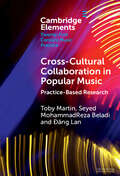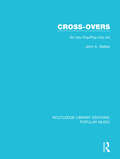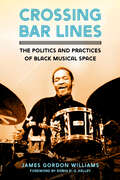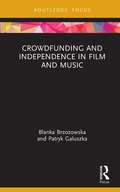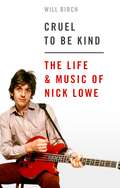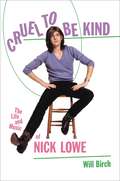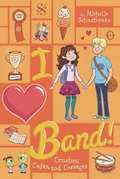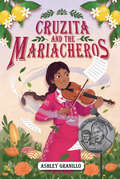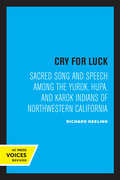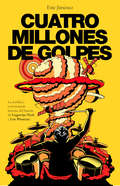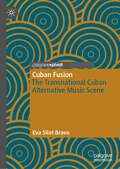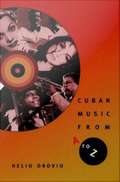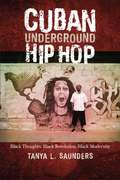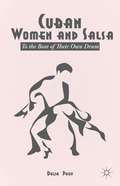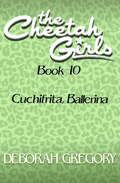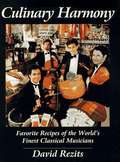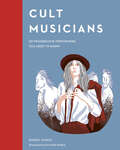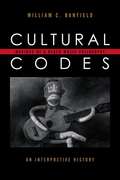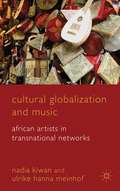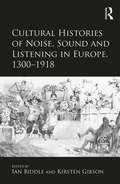- Table View
- List View
Cross-Cultural Collaboration in Popular Music: Practice-Based Research (Elements in Twenty-First Century Music Practice)
by Toby Martin Seyed Mohammadreza Beladi Dang LanCross-cultural collaboration in popular music represents opportunities for the audibility of multiple voices and the creation of new sounds, but it also presents many challenges. These challenges are both musical – that is, how to technically match voices – and ethical – that is, how to negotiate historically entrenched power discrepancies. Practice-based research has recently developed as a field in popular music studies. This burgeoning area has much to offer in terms of new knowledge, based on embodied insights, lived experience, and an arts practice. Through a practitioner-centred account of three projects involving traditional Persian and Vietnamese musicians, and western folk/rock musicians, the Element suggests pragmatic strategies and conceptual frameworks for making pop music with people of different cultural backgrounds.
Cross-Overs: Art Into Pop/Pop Into Art (Routledge Library Editions: Popular Music Ser. #3)
by John A. WalkerThis book, first published in 1987, was the first major survey of the links between the visual arts and pop music over the last thirty years. It brings to light the ideas, styles and people who have influenced both the look of pop and the shape of art. It examines how pop uses art movements like Dada, Futurism and Surrealism in everything from the design of album covers to the creation of a group’s look, stage act and video; how art uses pop, as a subject for painting, sculpture and design; the vital role of the British art school connection; and collaborations and cross-overs – between the visual arts and groups, musicians and movements.
Crossing Bar Lines: The Politics and Practices of Black Musical Space
by James Gordon WilliamsIn Crossing Bar Lines: The Politics and Practices of Black Musical Space James Gordon Williams reframes the nature and purpose of jazz improvisation to illuminate the cultural work being done by five creative musicians between 2005 and 2019. The political thought of five African American improvisers—trumpeters Terence Blanchard and Ambrose Akinmusire, drummers Billy Higgins and Terri Lyne Carrington, and pianist Andrew Hill—is documented through insightful, multilayered case studies that make explicit how these musicians articulate their positionality in broader society. Informed by Black feminist thought, these case studies unite around the theory of Black musical space that comes from the lived experiences of African Americans as they improvise through daily life. The central argument builds upon the idea of space-making and the geographic imagination in Black Geographies theory. Williams considers how these musicians interface with contemporary social movements like Black Lives Matter, build alternative institutional models that challenge gender imbalance in improvisation culture, and practice improvisation as joyful affirmation of Black value and mobility. Both Terence Blanchard and Ambrose Akinmusire innovate musical strategies to address systemic violence. Billy Higgins’s performance is discussed through the framework of breath to understand his politics of inclusive space. Terri Lyne Carrington confronts patriarchy in jazz culture through her Social Science music project. The work of Andrew Hill is examined through the context of his street theory, revealing his political stance on performance and pedagogy. All readers will be elevated by this innovative and timely book that speaks to issues that continue to shape the lives of African Americans today.
Crowdfunding and Independence in Film and Music (Routledge Focus on Media and Cultural Studies)
by Patryk Galuszka Blanka BrzozowskaThis book explores how independent film and music artists and labels use crowdfunding and where this use places crowdfunding in the contemporary system of cultural production. It complements an analysis of independence in film and music with the topic of crowdfunding as a firmly established form of financing cultural activity. In the second half of the 20th century, the concept of artistic independence was vital to classifying and distinguishing artists, their works, and labels or publishers who released them. However, during the last three decades, this term has become increasingly blurred, and some commentators argue that independence is in crisis. Can crowdfunding be the answer to this crisis? Some believe that it is, whereas others argue otherwise, seeing crowdfunding instead as just the next manifestation of this crisis. This dilemma is a starting point for the analyses of the relationships between crowdfunding and artistic independence conducted in this book, and will be of great interest to people looking for a deeper understanding of crowdfunding, how it can influence artistic independence, and what it means for artists and audiences. It will be a stimulating read for scholars and students with an interest in media and cultural studies, digital humanities, fandom, sociology, economics, business studies, and law, while also offering insights to artists and practitioners in the creative industries.
Crowe on the Banjo: The Music Life of J.D. Crowe (Music in American Life)
by Marty GodbeyIn this first biography of legendary banjoist J. D. Crowe, Marty Godbey charts the life and career of one of bluegrass's most important innovators. Born and raised in Lexington, Kentucky, Crowe picked up the banjo when he was thirteen years old, inspired by a Flatt & Scruggs performance at the Kentucky Barn Dance. Godbey relates the long, distinguished career that followed, as Crowe performed and recorded both solo and as part of such varied ensembles as Jimmy Martin's Sunny Mountain Boys, the all-acoustic Kentucky Mountain Boys, and the revolutionary New South, who created an adventurously eclectic brand of bluegrass by merging rock and country music influences with traditional forms. Over the decades, this highly influential group launched the careers of many other fresh talents such as Keith Whitley, Ricky Skaggs, Tony Rice, Jerry Douglas, and Doyle Lawson. With a selective discography and drawing from more than twenty interviews with Crowe and dozens more with the players who know him best, Crowe on the Banjo: The Music Life of J. D. Crowe is the definitive music biography of a true bluegrass original.
Cruel To Be Kind: The Life and Music of Nick Lowe
by Will Birch'Brilliant biography of an undersung late-blooming treasure . . . subtly profound as well as wickedly entertaining, this biography does its subject scintillating justice' MojoCruel to Be Kind is the definitive account of Nick Lowe's uncompromising life as a songwriter and entertainer, from his days at Stiff Records, to becoming the driving force behind Rockpile, to the 1979 smash hit 'Cruel To Be Kind'.Nick's original compositions have been recorded by the best in the business, from enfant terrible of the New-Wave, Elvis Costello, to 'The Godfather of Rhythm and Soul', Solomon Burke; from household names, including Engelbert Humperdink, Diana Ross, and Johnny Cash, to legendary vocalists such as Curtis Stigers, Tom Petty, and Rod Stewart.His reputation as one of the most influential musicians to emerge from that most formative period for pop and rock music is cast in stone. He will forever be the man they call the 'Jesus of Cool'.'Nick's poise as a singer, his maturity, and his use of tone is beautiful. I can't believe it's this guy I've been watching since I was a teenager' Elvis Costello, 2013'The master of subversive pop' Nick Kent, NME, 1977'Nick Lowe is such a f*cking good songwriter! Am I allowed to say that?' Curtis Stigers, 2016
Cruel to Be Kind: The Life and Music of Nick Lowe
by Will BirchThe definitive biography of singer-songwriter Nick Lowe, best-known for "Cruel to Be Kind" and "(What's So Funny 'Bout) Peace, Love, and Understanding" Described as "Britain's greatest living songwriter," Nick Lowe has made his mark as a pioneer of pub rock, power-pop, and punk rock and as a producer of Elvis Costello, Graham Parker, the Damned, and the Pretenders. He has been a pop star with his bands Brinsley Schwarz and Rockpile, a stepson-in-law to Johnny Cash and June Carter Cash, and is the writer behind hits including "Cruel to Be Kind" and "(What's So Funny 'Bout) Peace, Love, and Understanding." In the past decades, however, he has distinguished himself as an artist who is equally acclaimed for the second act of his career as a tender yet sharp-tongued acoustic balladeer. Biographer Will Birch, who in addition to being a music writer was a drummer and songwriter with The Records, has known Lowe for over forty years and melds Lowe's gift as a witty raconteur with his own authoritative analysis of Lowe's background and the cultural scenes he exemplifies. Lowe's parallel fame as one of the best interviews in the business will contribute to this first look into his life and work--and likely the closest thing fans will get to an autobiography by this notoriously charming cult figure.This is not an authorized biography, but Lowe has given it his spiritual blessing and his management and label are fully on board. Cruel to Be Kind will be the colorful yet serious account of one of the world's most talented and admired musicians.
Crunch Time (High School Musical Stories From East High #4)
by N. B. GraceThe pressure is on! The students of East High are preparing for SATs, and Gabriella has the unfortunate honor of tutoring Sharpay--who shines much more brightly onstage than she does on her practice tests. Luckily, the school's upcoming Halloween Festival is taking everyone's mind off the SAT crunch. This year's theme is Future Fantasy, and the students will wear costumes that represent what they would like to be someday. Gabriella and Troy are both wondering what kind of future the other foresees, but they'll have to wait until the party to find out. Bookshare has all of the books in this series about the kids at East High. Check out: #1 BATTLE OF THE BANDS, #2 WILDCAT SPIRIT, #3 POETRY IN MOTION, #4 CRUNCH TIME, #5 BROADWAY DREAMS, #6 Heart to Heart, #7 Friends 4Ever, #8 Get Your Vote On, #9 Ringin' It In, and #10 Turn Up The Heat.
Crushes, Codas, and Corsages #4
by Genevieve Kote Michelle SchustermanFormer band director Michelle Schusterman ends her adorable series about middleschool band geeks with the perfect coda! The band has been preparing for their big regional competition all year and it's time for all of their work to pay off. On top of preparing for competition, Holly is excited to go to the Spring Dance with Owen, but is he still interested after meeting a new girl at art camp over spring break? Holly and friends band together to have an amazing end to their seventh grade year.
Cruzita and the Mariacheros
by Ashley GranilloCruzita is going to be a pop star. All she has to do is win a singing contest at her favorite theme park and get famous. But she can’t go to the theme park this summer. Instead, she has to help out at her family’s bakery, which has been struggling ever since Tío Chuy died. Cruzita’s great-uncle poured his heart into the bakery—the family legacy—and now that he’s gone, nothing is the same. When Cruzita’s not rolling uneven tortillas or trying to salvage rock-hard conchas, she has to take mariachi lessons, even though she doesn’t know how to play her great-grandpa’s violin and she’s not fluent in Spanish. At first, she’s convinced her whole summer will be a disaster. But as she discovers the heart and soul of mariachi music, she realizes that there’s more than one way to be a star―and more than one way to carry on a legacy.
Cry for Luck: Sacred Song and Speech Among the Yurok, Hupa, and Karok Indians of Northwestern California
by Richard KeelingThe "sobbing" vocal quality in many traditional songs of northwestern California Indian tribes inspired the title of Richard Keeling's comprehensive study. Little has been known about the music of aboriginal Californians, and Cry for Luck will be welcomed by those who see the interpretation of music as a key to understanding other aspects of Native American religion and culture. Among the Yurok, Hupa, and Karok peoples, medicine songs and spoken formulas were applied to a range of activities from hunting deer to curing an upset stomach or gaining power over an uninterested member of the opposite sex. Keeling inventories 216 specific forms of "medicine" and explains the cosmological beliefs on which they were founded. This music is a living tradition, and many of the public dances he describes are still performed today. Keeling's comparative, historical perspective shows how individual elements in the musical tradition can relate to the development of local cultures and the broader sphere of North American prehistory. This title is part of UC Press's Voices Revived program, which commemorates University of California Press's mission to seek out and cultivate the brightest minds and give them voice, reach, and impact. Drawing on a backlist dating to 1893, Voices Revived makes high-quality, peer-reviewed scholarship accessible once again using print-on-demand technology. This title was originally published in 1992.
Crybaby: The Artists Who Shaped Emo Rap
by Donna-Claire ChesmanA revelatory examination of Emo Rap, from its inception to its incendiary ascent into the mainstream, including the critical artists that defined its sound and ethos, from Kid Cudi to Lil Peep, Lil Uzi Vert, XXXTentacion, and Juice WRLD.When Kid Cudi dubbed himself the &“lonely stoner,&” the texture of contemporary hip-hop was forever changed. The young rapper droned over purple blips and skitters on &“Day &‘N&’ Nite,&” unaware that he was terraforming the foundation of rap. As the decades wore on, the song came to symbolize a changing of the guard, and the next generation of kids were about to get really sad on the mic. Crybaby: The Artists Who Shaped Emo Rap chronicles the rise and fall of a genre born from suburban malaise. From Atmosphere giving emo its name in the late &’90s, to Juice WRLD capturing every corner of rap&’s attention with his wailing high school angst, this was the definitive sound of bugged out youth. Emo rap is visceral. It&’s Lil Peep with the pink and black split dye, singing about bleeding out after getting dumped; Lil Uzi Vert making a suicidal club smash that soundtracks lavish Las Vegas day parties; XXXTentacion stirring controversy while topping the charts with &“Sad!&” Artists recorded into old computers and these records traveled through the digital portals of SoundCloud. They didn&’t need record deals; they just needed WiFi. Listeners and their favorite acts had a singular meeting ground: everyone was trapped in their bedrooms and hoping to feel something. A network of reposts, comments, and word-of-mouth allowed the genre to bubble up nationally. While the press didn&’t know what to make of Yung Lean and the Sad Boys&’ viral rise online, the fans understood on contact that this was their music. By the turn of the decade, the three most prominent emo rappers—Lil Peep, XXXTentacion, and Juice WRLD—had lost their lives to overdoses and gun violence. Stunted by tragedy, Emo shrunk down into an ornament to decorate pop-rap tunes. We&’re now a far cry from Juice&’s &“All Girls Are The Same&” rewriting the mainstream playbook as the next iteration of &“Day &‘N&’ Nite.&” But the numbers for the young artists we&’ve lost tell a story of resilience. For those who were there during the whirlwind of the 2010s, emo&’s imprint has not faded. Millions upon millions of fans worldwide turn to this music as twilight grips them and they stare off into their own emotional voids. It&’s whiny. It&’s base. And it speaks to the truth of the matter: every era will have its crybabies.
Cuatro millones de golpes
by Eric JiménezLa insólita historia del mejor batería español de todos los tiempos, y de su grupo, Los Planetas, contada por primera vez desde dentro de la banda. Con seis años mi padre me encañonó con una pistola. Ni siquiera recuerdo su nombre. Con diez ingresé en la Falange porque quería tocar el tambor. Mis mayores influencias musicales han sido la Semana Santa y mi primera hostia, la que me dieron al nacer, quizá la más artística y la menos dolorosa. Me casé con dieciséis. Más tarde empecé a consumir drogas para evadirme. Debería haber muerto antes de los treinta. Durante estos cuarenta años he golpeado la batería como la vida me ha golpeado a mí, con todas sus fuerzas. Pero juro que este no es un libro triste. Os prometo que al leerlo os reiréis y amaréis la música casi tanto como lo hago yo. Reseña:«Narrada con una voz a tumba abierta, de una sinceridad brutal que no elude ni esconde, Cuatro millones de golpes es un relato ágil y apasionante, que se lee con devoción si se es capaz de buscar entre sus líneas las sombras que se ocultan más allá de los focos.»Manolo D. Abad, suplemento Culturas del diario El Comercio En los blogs...«Lo que realmente importa es que su vida da para un libro como este porque está llena de luces y sombras y eso es lo que la hace verdaderamente interesante.»Blog Books and Co «Tanto sus historias como la música, sin duda en todas y cada una de sus palabras se aprecia que destila amor por la música y eso acaba calando hondo en el lector.»Blog Popera parada «Es muy recomendable para fans de Los Planetas y también para todos aquellos interesados en los últimos cuarenta años de la historia musical de este país. Aunque si por algo destaca es por la arrolladora personalidad del autor.»Blog Todo Indie
Cuba and Its Music: From the First Drums to the Mambo
by Ned SubletteThis entertaining history of Cuba and its music begins with the collision of Spain and Africa and continues through the era of Miguelito Valdés, Arsenio Rodríguez, Benny Moré, and Pérez Prado. It offers a behind-the-scenes examination of music from a Cuban point of view, unearthing surprising, provocative connections and making the case that Cuba was fundamental to the evolution of music in the New World. The ways in which the music of black slaves transformed 16th-century Europe, how the claves appeared, and how Cuban music influenced ragtime, jazz, and rhythm and blues are revealed. Music lovers will follow this journey from Andalucía, the Congo, the Calabar, Dahomey, and Yorubaland via Cuba to Mexico, Puerto Rico, Saint-Domingue, New Orleans, New York, and Miami. The music is placed in a historical context that considers the complexities of the slave trade; Cuba's relationship to the United States; its revolutionary political traditions; the music of Santería, Palo, Abakuá, and Vodú; and much more.
Cuban Fusion: The Transnational Cuban Alternative Music Scene
by Eva Silot BravoSurveying the impact of Cuba's economic crisis after the demise of the eastern socialist block, this book documents a relatively unexplored transnational network of collaborations among Cuban musicians that migrated to many different countries from the 1990s forward. The book’s main argument is that in light of the 1990s crisis in Cuba, new transnational and alternative narratives emerged, resulting in creative “in-between” spaces that reflect a post- socialist aesthetic condition. The manuscript also documents important developments in the Cuban jazz and fusion scenes outside the island in the last 20+ years..
Cuban Music from A to Z
by Helio OrovioAvailable in English for the first time, Cuban Music from A to Z is an encyclopedic guide to one of the world's richest and most influential musical cultures. It is the most extensive compendium of information about the singers, composers, bands, instruments, and dances of Cuba ever assembled. With more than 1,300 entries and 150 illustrations, this volume is an essential reference guide to the music of the island that brought the world the danzn, the son, the mambo, the conga, and the cha-cha-ch. The life's work of Cuban historian and musician Helio Orovio, Cuban Music from A to Z presents the people, genres, and history of Cuban music. Arranged alphabetically and cross-referenced, the entries span from Abaku music and dance to Eddy Zervign, a Cuban bandleader based in New York City. They reveal an extraordinary fusion of musical elements, evident in the unique blend of African and Spanish traditions of the son musical genre and in the integration of jazz and rumba in the timba style developed by bands like Afrocuba, Chucho Valds's Irakeke, Jos Luis Corts's ng La Banda, and the Buena Vista Social Club. Folk and classical music, little-known composers and international superstars, drums and string instruments, symphonies and theaters--it's all here.
Cuban Underground Hip Hop: Black Thoughts, Black Revolution, Black Modernity (Latin American And Caribbean Arts And Culture)
by Tanya L. SaundersIn the wake of the 1959 Cuban Revolution, a key state ideology developed: racism was a systemic cultural issue that ceased to exist after the Revolution, and any racism that did persist was a result of contained cases of individual prejudice perpetuated by US influence. Even after the state officially pronounced the end of racism within its borders, social inequalities tied to racism, sexism, and homophobia endured, and, during the economic liberalization of the 1990s, widespread economic disparities began to reemerge. <p><p> Cuban Underground Hip Hop focuses on a group of self-described antiracist, revolutionary youth who initiated a social movement (1996–2006) to educate and fight against these inequalities through the use of arts-based political activism intended to spur debate and enact social change. Their “revolution” was manifest in altering individual and collective consciousness by critiquing nearly all aspects of social and economic life tied to colonial legacies. Using over a decade of research and interviews with those directly involved, Tanya L. Saunders traces the history of the movement from its inception and the national and international debates that it spawned to the exodus of these activists/artists from Cuba and the creative vacuum they left behind. Shedding light on identity politics, race, sexuality, and gender in Cuba and the Americas, Cuban Underground Hip Hop is a valuable case study of a social movement that is a part of Cuba’s longer historical process of decolonization.
Cuban Women and Salsa
by Delia PoeySalsa is both an American and transnational phenomenon, however women in salsa have been neglected. To explore how female singers negotiate issues of gender, race, and nation through their performances, Poey engages with the ways they problematize the idea of the nation and facilitate their musical performances' movement across multiple borders.
Cuchifrita, Ballerina: Cuchifrita, Ballerina (The Cheetah Girls #10)
by Deborah GregoryChanel has never written a song before, and she&’s overjoyed when her first effort, &“It&’s Raining Benjamins,&” proves a hit for the Cheetah Girls. But when another group accuses her of stealing lyrics, Chanel admits that not all the words were her own. Broken-hearted and ashamed, Chanel is so low that she&’s considering taking up ballet, which could mean giving up on the Cheetah Girls—for good!American Ballet Theatre is recruiting junior dancers, and Chanel is going to get on that dance team no matter what it takes. But pliés and pirouettes are no substitute for true friendship, and Chanel will have to be on pointe if she is to keep the Cheetahs close to her heart.
Culinary Harmony: Favorite Recipes of the World's Finest Classical Musicians
by David RezitsA detailed biography accompanies each musician, allowing readers to get to know the artists, while mastering their tasty recipes.
Cult Musicians: 50 Progressive Performers You Need to Know (Cult Figures)
by Robert Dimery“Even the most avid music fan will make some new discoveries in these pages.” —The CurrentWhat makes a cult musician? Whether pioneering in their craft, fiercely and undeniably unique, or critically divisive, cult musicians come in all shapes and guises. Some gain instant fame, others instant notoriety, and more still remain anonymous, with small, devout followings, until a chance change in fashion sees their work propelled into the limelight.Cult Musicians introduces fifty beyond-the-mainstream musicians deserving of a cult status in genres from afrobeat and art pop to glam rock and proto punk. Weird and wonderful, innovators and boundary breakers, they include Alex Chilton and Aphex Twin, Bobbie Gentry and Brian Eno, Kat Bjelland and Kool Keith, Nick Drake and Nick Cave—and dozens more with a special ability to inspire, antagonize, and delight. Included are insightful profiles, discographies, and striking illustrations by Kristelle Rodeia.
Cultural Codes: Makings Of A Black Music Philosophy - An Interpretive History From Spirituals To Hip Hop (African American Cultural Theory And Heritage Series)
by William C. Banfield Bill Banfield"No art can survive without an understanding of, and dedication to, the values envisioned by its creators. No culture over time has existed without a belief system to sustain its survival. Black music is no different. In Cultural Codes: Makings of a Black Music Philosophy, William C. Banfield engages the reader in a conversation about the aesthetics and meanings that inform this critical component of our social consciousness." <P><P>"By providing a focused examination of the historical development of Black music artistry, Banfield formulates a useable philosophy tied to how such music is made, shaped, and functions. In so doing, he explores Black music culture from three angles: history, education, and the creative work of the musicians who have moved the art forward. In addition to tracing Black music from its African roots to its various contemporary expressions, including jazz, soul, R&B, funk, and hip hop, Banfield profiles some of the most important musicians over the last century: W.C. Handy, Scott Joplin, Louis Armstrong, Duke Ellington, Count Basie, Mary Lou Williams, John Coltrane, James Brown, Jimi Hendrix, and Stevie Wonder, among others. Cultural Codes provides an educational and philosophical framework for students and scholars interested in the traditions, the development, the innovators, and the relevance of Black music."--BOOK JACKET.
Cultural Globalization and Music
by Nadia Kiwan Ulrike Hanna MeinhofThis book is about South-North, North-South relations between Africa and Europe, presenting the personal narratives of musicians in different locations across Africa and Europe, and those of the people who constitute their networks within the wider artistic, cultural, and civil society milieus of globalizing societies.
Cultural Histories of Noise, Sound and Listening in Europe, 1300-1918: )
by Ian Biddle Kirsten GibsonCultural Histories of Noise, Sound and Listening in Europe, 1300-1918 presents a range of historical case studies on the sounding worlds of the European past. The chapters in this volume explore ways of thinking about sound historically, and seek to understand how people have understood and negotiated their relationships with the sounding world in Europe from the Middle Ages through to the early twentieth century. They consider, in particular: sound and music in the later Middle Ages; the politics of sound in the early modern period; the history of the body and perception during the Ancien Régime; and the sounds of the city in the nineteenth century and sound and colonial rule at the fin de siècle. The case studies also range in geographical orientation to include considerations not only of Britain and France, the countries most considered in European historical sound studies in English-language scholarship to date, but also Bosnia-Herzegovina, British Colonial India, Germany, Italy and Portugal. Out of this diverse group of case studies emerge significant themes that recur time and again, varying according to time and place: sound, power and identity; sound as a marker of power or violence; and sound, physiology and sensory perception and technologies of sound, consumption and meaning.
Cultural Identity in British Musical Theatre, 1890–1939: Knowing One's Place (Palgrave Studies In British Musical Theatre Ser.)
by Ben MacphersonThis book examines the performance of ‘Britishness’ on the musical stage. Covering a tumultuous period in British history, it offers a fresh look at the vitality and centrality of the musical stage, as a global phenomenon in late-Victorian popular culture and beyond. Through a re-examination of over fifty archival play-scripts, the book comprises seven interconnected stories told in two parts. Part One focuses on domestic and personal identities of ‘Britishness’, and how implicit anxieties and contradictions of nationhood, class and gender were staged as part of the popular cultural condition. Broadening in scope, Part Two offers a revisionary reading of Empire and Otherness on the musical stage, and concludes with a consideration of the Great War and the interwar period, as musical theatre performed a nostalgia for a particular kind of ‘Britishness’, reflecting the anxieties of a nation in decline.
